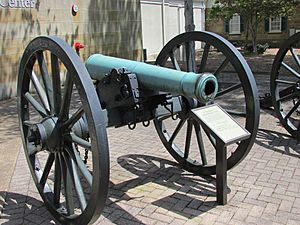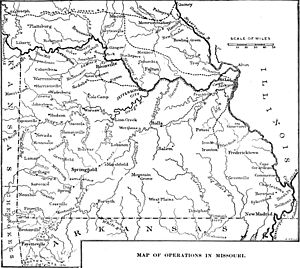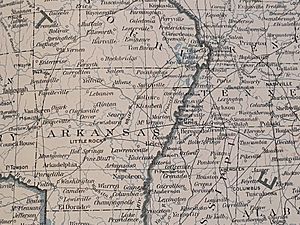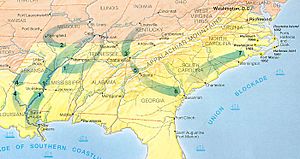1st Missouri Field Battery facts for kids
Quick facts for kids
|
|
|---|---|

A 6-pounder smoothbore gun of the type issued to the battery
|
|
| Active | c. September 7, 1862 to June 7, 1865 |
| Allegiance | Confederate States |
| Branch | Confederate States Army |
| Type | Artillery |
| Engagements | |
The 1st Missouri Field Battery was a special group of soldiers who used cannons, called a field artillery battery. They fought for the Confederate States Army during the American Civil War. This group was first formed in Arkansas in September 1862 by Captain Westley F. Roberts. It was known as Roberts' Missouri Battery.
At first, the battery had two 12-pounder James rifles and two 6-pounder smoothbore cannons. They fought in the Battle of Prairie Grove on December 7, 1862. After this battle, Roberts' Battery moved to Little Rock, Arkansas. Captain Roberts then left, and Lieutenant Samuel T. Ruffner took command. The unit then became known as Ruffner's Missouri Battery.
In 1863, Ruffner's Battery helped stop Union ships on the Mississippi River. Later, they returned to Little Rock because Union forces were threatening the city. The Confederates left Little Rock on September 10, and Ruffner's Battery helped protect the soldiers as they retreated. After this, the battery joined Brigadier General John S. Marmaduke's cavalry (horseback soldiers). They fought in the Battle of Pine Bluff on October 25.
In 1864, the battery received new cannons: two 10-pounder Parrott rifles and two 12-pounder howitzers. They moved to Louisiana to fight in the Red River campaign. Although they were at the Battle of Pleasant Hill, they were kept in reserve and did not fight. Later, they returned to Arkansas and fought in the Battle of Jenkins' Ferry on April 30. During this battle, they lost some of their cannons. After this, they were given four new 6-pounder smoothbore cannons.
In November 1864, the unit was officially named the 1st Missouri Field Battery. They spent the rest of the war in Louisiana and Arkansas. The war ended for them on June 7, 1865, when they were released from service in Alexandria, Louisiana.
Contents
How the Battery Started
The American Civil War began in 1861. The state of Missouri was a slave state, but it did not immediately join either side. People in Missouri were divided between supporting the Confederate States and staying with the Union.
The Governor of Missouri, Claiborne Fox Jackson, supported the Confederates. He gathered state soldiers near St. Louis. However, Union General Nathaniel Lyon quickly broke up this group. This led to riots in St. Louis. In response, Governor Jackson formed the pro-Confederate Missouri State Guard. Major General Sterling Price led this new group.
Union forces pushed Jackson and Price out of the state capital, Jefferson City. They were also forced out of Boonville. Jackson and Price moved to southwestern Missouri, with Union forces following them.
In August, Price's Missouri State Guard joined with Confederate troops led by Brigadier General Benjamin McCulloch. On August 10, Union General Lyon attacked them at the Battle of Wilson's Creek. Lyon was killed, and the Union forces lost the battle. Price then moved north and successfully took over Lexington in September.
Union forces later pushed Price south. He went to Neosho, where Governor Jackson joined him. On November 3, Jackson and the pro-Confederate lawmakers voted for Missouri to leave the Union and join the Confederate States. They acted as a government-in-exile, meaning they were a government without a fixed home.
In February 1862, Union forces pushed Price out of Missouri into Arkansas. In March, Price, McCulloch, and Major General Earl Van Dorn combined their forces to create the Army of the West. They fought the Battle of Pea Ridge on March 7 and 8. McCulloch was killed, and the Confederates were defeated. After this battle, the Army of the West moved to Van Buren, Arkansas. Many Missouri soldiers then joined the official Confederate States Army. Around September 7, 1862, in Van Buren, Captain Westley F. Roberts formed his field artillery battery.
Cannons Used by the Battery
In October, Roberts' Battery received its cannons. They had two 12-pounder James rifles, which were captured from Union forces. They also had two older 6-pounder smoothbore cannons. The James rifles had spiral grooves inside their barrels. These grooves made the cannonball spin, which helped it fly farther and more accurately. The James rifles could shoot about 1,700 yards (1,554 meters). The 6-pounder smoothbores could shoot about 1,500 yards (1,372 meters). Both types were field guns, meaning they fired cannonballs in a flat path over long distances.
Later in the war, the battery used two 10-pounder Parrott rifles and two 12-pounder howitzers. Parrott rifles could shoot even farther, up to 3,200 yards (2,926 meters). Howitzers fired shells in a high arc, which was useful for shooting over hills or other obstacles. Confederate artillery often had problems with their gunpowder and fuses, which sometimes caused shells to explode too early. Each cannon needed a crew of four to six soldiers to operate it.
Battery's Service History
1862 Battles
On December 7, 1862, Roberts' Battery fought in the Battle of Prairie Grove in Arkansas. They were part of Colonel Robert G. Shaver's brigade. At first, they were held back as a reserve unit. But then, they were ordered to move to the right side of the Confederate battle line.
Roberts' Battery moved onto a ridge, which gave them a clear view of the Union forces. Because of the rough ground, they could only use their two James rifles, even though the two 6-pounders were still with them. These James rifles were the only cannons with spiral grooves (rifled cannons) the Confederates had at Prairie Grove.
The battery came under heavy Union fire. They moved to a new spot, but the Union cannons kept firing, making their position unsafe. Roberts decided the battery could not stay there, so the gunners left their cannons and took cover in nearby woods. The battery fought for two hours. They damaged two Union cannons and wounded a Union soldier. When night came, the Confederates retreated. To hide the sound of their retreat, they wrapped blankets around the wheels of their cannons. They retreated for two days until they reached Van Buren.
1863 Engagements
By January 6, 1863, the battery was in Little Rock, Arkansas. Captain Roberts resigned, and Lieutenant Samuel T. Ruffner became the new commander. The battery was then called Ruffner's Missouri Battery. In February, they traveled by steamboat to Pine Bluff, Arkansas. They were stationed at a place called Fort Pleasant.
In June, Ruffner's Battery moved near the Mississippi River to disrupt Union shipping. They had four 6-pounder cannons. They fired at Union Navy ships on June 22 and 27. On June 28, they had a small fight with Union soldiers and cavalry near Gaines' Landing.
In late July, the battery returned to Little Rock because Union forces were getting close. The Confederates left Little Rock on September 10 without a fight. On September 11, Ruffner's Battery helped protect the retreating Confederate soldiers. Union cavalry were chasing them. Ruffner's Battery fired their four cannons at the Union soldiers, causing them to suffer losses. After more fighting, the retreat continued without further pursuit. After leaving Little Rock, Ruffner's Battery temporarily joined Marmaduke's cavalry division.
Battle of Pine Bluff
After taking Little Rock, Union troops occupied several towns along the Arkansas River. Pine Bluff was held by Union cavalry. On October 25, Marmaduke attacked Pine Bluff. The Union cavalry built barricades in the town square. Marmaduke's cavalry attacked but got stuck. Ruffner's Battery, which had been held back, was then called to help.
The battery set up on the right side of the Confederate line. They fired three cannons at the Union position near the courthouse. Their cannon fire forced some Union defenders to move, but the main Union line held strong. More Confederate cavalry attacks failed to break through. Marmaduke's men then left after some looting.
On December 2, the battery's time with Marmaduke's division ended. They returned to Fort Pleasant without their cannons, which were given to another battery. At Fort Pleasant, Ruffner's Battery received new cannons from a unit that had stopped fighting: two 10-pounder Parrott rifles and two 12-pounder howitzers.
1864 and 1865 Actions
The battery then joined a new group led by Colonel Clark, which was part of Brigadier General Mosby M. Parsons's division. In March 1864, Parsons's division moved to Louisiana. They were there to stop a Union attack up the Red River. On April 9, Parsons's division fought in the Battle of Pleasant Hill. Ruffner's Battery was in reserve and did not fight. Even though the Confederates pushed back the Union army, the Union forces continued to retreat.
After Pleasant Hill, General Edmund Kirby Smith, the overall Confederate commander, moved his soldiers back to Arkansas. Union General Steele had taken over Camden. Steele's supplies were running low, and he had lost battles at Poison Spring and Marks' Mills. Running out of food, the Union troops left Camden on April 26, hoping to retreat to Little Rock. The Confederates chased them and caught up at the Saline River on April 30.
Battle of Jenkins' Ferry
On the morning of April 30, at the Battle of Jenkins' Ferry, Ruffner's Battery and another battery moved into position to support an attack by Parsons's Division. When the Confederate soldiers attacked, Ruffner's Battery moved forward to support them. However, the attack failed, leaving the two batteries exposed.
Visibility on the battlefield was poor. Ruffner's Battery accidentally moved close to the 2nd Kansas Colored Infantry Regiment, thinking they were Confederate soldiers. Because of this mistake, the 2nd Kansas Colored Infantry captured two or three of the battery's cannons. After the attack failed, the Confederate soldiers pulled back. The battery had 17 soldiers killed or captured at Jenkins' Ferry.
Later that day, Steele's Union soldiers crossed the Saline River using a temporary bridge. They reached Little Rock on May 2. Ruffner's Battery was given four new cannons, all 6-pounder smoothbores. After Jenkins' Ferry, the unit did not fight in any more battles. They spent the rest of the war in Arkansas and Louisiana.
On November 19, the battery was officially named the 1st Missouri Field Battery. General Edmund Kirby Smith signed the surrender terms for the Confederate forces in the Trans-Mississippi Department on June 2, 1865. The men of the 1st Missouri Field Battery were released from service five days later, on June 7, 1865, in Alexandria, Louisiana. This ended their time fighting in the war. About 170 men served in the battery during its existence. At least six were killed in battle, and at least four more died from illnesses.
Images for kids







